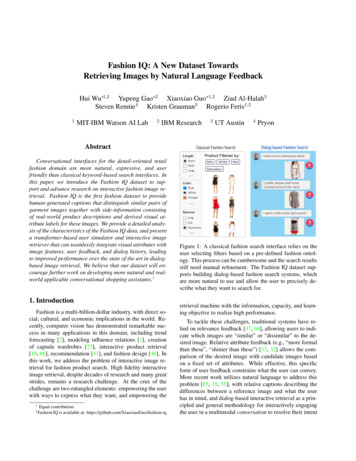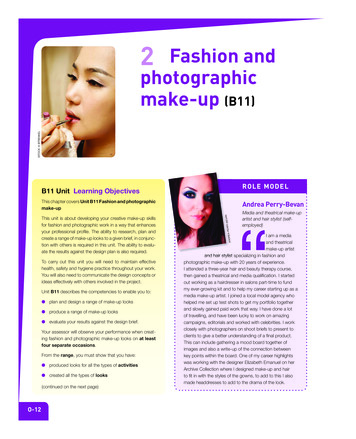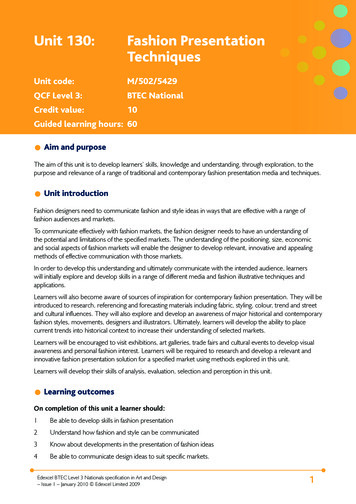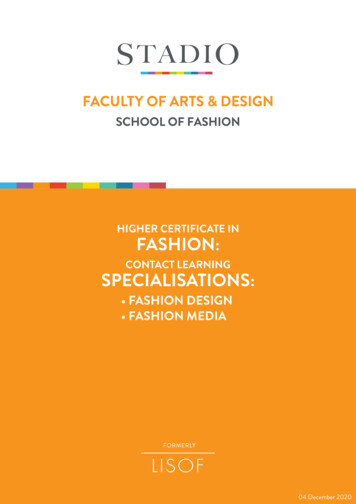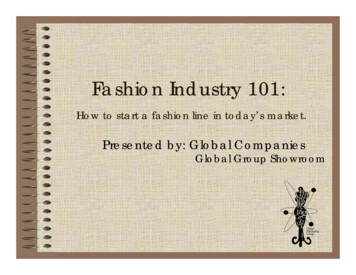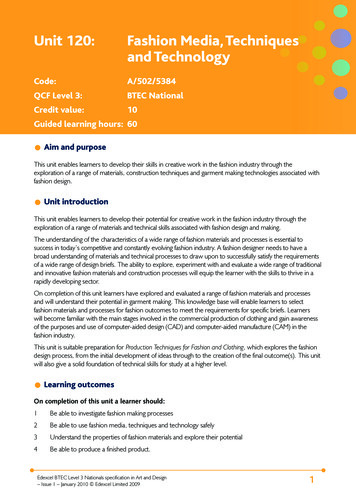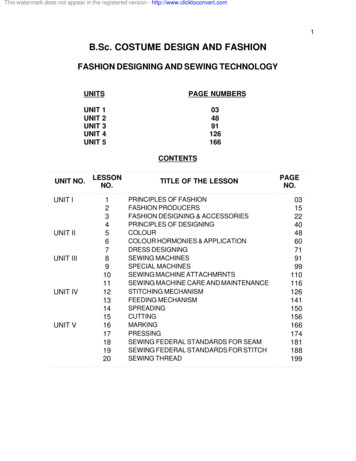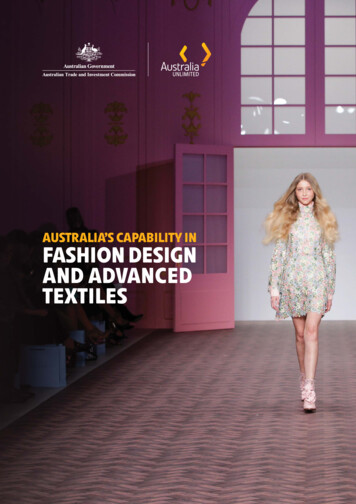
Transcription
AUSTRALIA’S CAPABILITY INFASHION DESIGNAND ADVANCEDTEXTILES
CONTENTSIntroduction01Leading design education and fashion designers 06Industry overview02Further information08Industry strengths03About Austrade09DisclaimerThis report has been prepared by the Commonwealth of Australiarepresented by the Australian Trade and Investment Commission(Austrade). The report is a general overview and is not intended toprovide exhaustive coverage of the topic. The information is madeavailable on the understanding that the Commonwealth of Australia isnot providing professional advice.While care has been taken to ensure the information in this report isaccurate, the Commonwealth does not accept any liability for any lossarising from reliance on the information, or from any error or omission,in the report.Any person relying on this information does so at their own risk. TheCommonwealth recommends the person exercise their own skill andcare, including obtaining professional advice, in relation to their use ofthe information for their purposes.The Commonwealth does not endorse any company or activity referredto in the report, and does not accept responsibility for any lossessuffered in connection with any company or its activities.Cover image courtesy of macgraw.Back cover image courtesy of Tourism Australia/Time Out Australia.Copyright Commonwealth of Australia 2018The material in this document is licensed under a Creative CommonsAttribution – 4.0 International licence, with the exception of: the Australian Trade and Investment Commission’s logo any third party material any material protected by a trade mark any images and photographs.More information on this CC BY licence is set out at the creativecommons 0/legalcode.Enquiries about this licence and any use of this document can be sentto onBefore reusing any part of this document, including reproduction, publicdisplay, public performance, distribution, dissemination, communication,or importation, you must comply with the Attribution requirements underthe CC BY licence.17-18-14. Publication date: March 2018.
INTRODUCTIONAustralia is a leader in the fashion design, textiles and apparels sector. Supported by prominenteducation and research institutions, the Australian industry is driving advances across design,textile innovation and fabric development.With a wide range of internationally successfulcompanies, Australian textile and apparel businessesare familiar with the challenges of operating in a globalindustry valued at US 3 trillion.1Shifts in consumer demand patterns, new distributionmodels and the increased role of advancedtechnologies are creating international opportunitieswhere Australia has a competitive advantage.Examples of Australian diversification and innovationinclude the fire-resistant textile technologies developedby the Royal Melbourne Institute of Technology (RMIT)and a denim dyeing project at Deakin University toincrease the global sustainability of one of the world’smost popular clothing items.Some examples of internationally successful Australianfashion companies include Cotton On Group (CottonOn, Supre, Ruby and Factorie); Specialty Fashion Group(Millers, Crossroads, Katies, Rivers, City Chic); CountryRoad Group (Country Road, Mimco, Politix, Trenery andWitchery) and Premier Investments (Smiggle, Just Jeans,Portmans, Peter Alexander, dotti, and Jacquie-E).This industry capability statement provides an overviewof Australian capability in fashion design, innovativetextiles and apparel, including examples of some of themany Australian companies with specialist expertise.Talk to your local Austrade representative for moretailored advice and information on connecting andpartnering with this industry.Image courtesy of macgraw.Australia’s capability in fashion design and advanced textiles1
INDUSTRYOVERVIEWLeading design, textile innovationand fabric developmentThe Australian textile and apparel industry playsa substantial role across the economy includingin design, education, fibre production, services,research and technology.Australia’s experience in fibre production, designand research underpins our capability in this sector.Historically known for its success through leading surfand activewear companies such as Billabong, Rip Curland more recently Lorna Jane, Australia’s reputation asa healthy, active society has contributed to its impact ininternational markets.The industry is continually diversifying, and has shiftedAustralia’s position to an innovator of smart textiles, highquality fibres, leading design education and unique fabricdevelopment. Government organisations such as CSIROand major universities like RMIT and Deakin Universityare at the forefront of this. Australian businesses areutilising new technologies to develop and complementtheir product offering, often partnering with innovators.The Skins partnership with Deakin University to analysehuman sweat conditions for their compression garmentsis a prime example.The industry is poised for a dynamic period aheadwith increased demand from the growing middle-classof Asian markets, significant growth in e-commerceglobally, improvements in textile technology, innovativefabrics and world-class education capabilities.Australia’s 27 years of uninterrupted economic growth hasgiven rise to innovative new businesses that are buildingtheir international reputations with global supply chains.Australia is well positioned in this changing environmentwith a flexible industry and strong creative talent.KEY INDUSTRY FACTS 5 BILLION WORTH OFEXPORTS IN FASHION2 12 BILLION CONTRIBUTIONTO THE AUSTRALIANECONOMY3220,000 STRONGWORKFORCE4 2.9 BILLION IN WOOLEXPORTS5 2.5 BILLION IN COTTONEXPORTS6Image courtesy of RMIT.2Australia’s capability in fashion design and advanced textiles
INDUSTRYSTRENGTHSExcellence in advanced textilesThe Australian advanced textile industry benefits froman integrated design capability through its universities,industrial design and vibrant local fashion. This issupported by the development of natural fibres whichenables fast product development and strong enduser focus. With high-tech and flexible manufacturing,developments are assisted by small runs, prototypingand mass customisation capability.Australia has developed some of the world’s best naturalfibres through continued research and development.The Woolmark company runs an international fashionaward – the International Woolmark Prize – to furtherthe innovation of wool fabrics.The CSIRO and the NSW Department of Agriculturehave a program to continually improve Australia’s cottonproduction, focused on water usage, pest managementand cotton quality. This research investment underpinsthe Australian cotton industry, and the industry isrecognised as a world leader in the adoption oftechnology, innovation, environmental management andthe production of high-quality, high-yielding cotton.With technology that is globally relevant to Australia’sadvanced textiles industry, the future of textiles hasan international outlook. Companies and researchinstitutions are well connected and highly capable ofcollaborating across borders and between markets.Some examples include:››Imagine Intelligent Materials has developed sensingmaterials by incorporating graphene, a twodimensional sheet of carbon atoms, into textiles.Imagine Intelligent Materials is working with a numberof Australian universities towards a world that isseamlessly connected by intelligent materials thatrespond to their environment through convergencewith electronics (e.g. clothes that make a phone callby connecting materials to devices – made possiblethrough graphene’s electrical conductivity).››Textor Technologies, a high-volume non-wovenhealthcare fabrics manufacturer, has partnered withAustralia’s CSIRO to develop the 3D UltraAbsorbtechnology for inclusion in Kimberly-Clark babynappies. This technology draws wetness away fromthe skin leaving it dry. It is now being exported aroundthe world into the growing baby diaper market.›› he Institute for Frontier Materials (IFM) at DeakinTUniversity won the Global Change Award in 2017for innovation in fashion, presented by the H&MFoundation in Sweden. The award was for thedevelopment of a new denim dyeing process thatreduces water usage by up to 2,000 litres per garment.IFM is also the home of Carbon Nexus, a purpose-builtresearch facility for carbon fibre, partnering with keylocal and global composite companies.For example, RMIT University’s Centre for MaterialsInnovation and Future Fashion (CMIFF) draws togetherthe end-user design focus with textile technology tosolve industry problems. This includes developments thatprotect cyclists from grazing injuries while maintainingcomfort and performance, and car seat covers thatoperate safely in tandem with airbags.Australian advanced textiles companies are focused onthe integration of smart and functionalised textiles intofuture applications. This includes the Internet of Things,healthcare and high performance apparel. Companiesare collaborating with Australian universities andresearch institutes in the development of new materialsand their application into textile substrates and realproducts that are valued by end users.Image courtesy of Australian Fashion Council.Australia’s capability in fashion design and advanced textiles3
Image courtesy of macgraw.MACGRAW LABEL CREATES A WINNING WAY WITH AUSTRALIANMERINO WOOLCase studyBeth and Tessa MacGraw launched their label macgraw in April 2012. The sisters have since carved their placein the Australian designer landscape with a keen eye for beautiful fabrications in wearable silhouettes.The designers created a new technique with merino wool, a superfine 100% merino lace that doesn’t crease.macgraw worked closely with a Swiss guipure manufacturer, a leading lace supplier to fashion houses includingGucci, to create a world first – lace made from superfine Australian merino wool rather than cotton or polyester.“It took some convincing but they finally agreed to work with us,” said Tessa MacGraw. “They had to pull aside aSchiffli machine from their regular order run to test different weights and thicknesses of wool because they usuallyuse cotton, silk and polyester yarns.”Success was finally achieved with a superfine 2/80 yarn that was used to create a lace that doesn’t crease, hasa unique drape, and the warmth and comfort of merino.This innovation is now being offered to luxury design houses worldwide. “They developed an entirely new way ofproducing wool,” said IWP judge and netaporter founder Natalie Massenet. “We’ll be able to wear lace in winterand still be warm. To a girl that’s a dream come true.”macgraw debuted at Mercedes-Benz Fashion Week Australia in April 2014 to critical acclaim. Elle Australialabeled them ‘designers you need to know’. The label now shows annually at Mercedes-Benz Fashion Week,supporting showrooms in Paris and NYC.In 2016, macgraw won four of Australia’s top design awards. These included the Tiffany & Co. National DesignerAward, the BT Award, the Regional International Woolmark Prize and the Australian Fashion Laureate for BestEmerging Designer.In four years, macgraw has attracted a strong fan base of luxury dressers who appreciate easy yet unique anddetail-oriented design. The brand counts Lorde, Banks, Karlie Kloss and Coco Rocha as fans and has enjoyed anod of approval from Harper’s Bazaar USA, which after meeting the designers, published an article entitled ‘Meetthe Aussie brand that will make your summer’.In early 2017 in Paris, the designers presented a capsule Woolmark collection to an esteemed industry panelcomprising Dame Natalie Massenet, Bouchra Jarrarr of Lanvin and Victoria Beckham.Despite overseas expansion and international success, macgraw maintains a proudly Australian attitude thatthe sisters believe gives them a global advantage when it comes to professionalism and personality.“Australians in general are positive people with a strong work ethic; people overseas really gravitate to that,”said Beth MacGraw. “In a design context, there is a sense of ease in our silhouettes that also comes from beingAustralian.”macgraw.com.au4Australia’s capability in fashion design and advanced textiles
iStab test – image courtesy of RMIT.iStab test – image courtesy of RMITRMIT DEVELOPS ABRASION-RESISTANT KNITTED FABRICS FOR ATHLETESCase studyRMIT University’s Centre for Materials Innovation and Future Fashion (CMIFF) has been working withAustralian company GRT P/L to provide improved crash protection for leading competition cyclistsand athletes.The project has investigated how cyclists can be better protected against abrasions should they falland slide along a road surface. Grazing injuries are often severe and debilitating, with removal of skinand under-tissue over significant areas of the body.The existing commercially available cycling garments provided no abrasion protection as they aredesigned for streamlined comfort and minimal effect on the performance of the cyclist. Internationalrules also preclude the coverage of knees and elbows.GRT requested that RMIT develop suitable knitted fabrics providing significantly improved abrasionprotection, with all the other functions of the fabrics and garments unaffected. The material neededto be fully coloured and able to be printed on. Ideally, it would also provide some degreeof moisture management and control over thermal performance.The fabric manufacture was carried out by RMIT’s expert knitting technicians, based on a variety of CMIFFdesigns. As part of this process, a customised abrasion test machine was developed in RMIT’s CMIFFlaboratories to test the specific fabric problems and conditions. This machine was based on the existinginternational standards used to evaluate motorcycle gear.RMIT evaluated the test results and adapted the fabric designs and manufacture processes so that after eachevaluation, steady improvements in abrasion performance were achieved until an optimum set of design criteriawere formulated.A suite of the best-performing fabrics were then taken by GRT to a leading global sports/activewear brand.The brand identified a range of additional applications for the new fabric technology that could benefit otheritems in their product ranges.The first product using this abrasion protection technology was released in September 2016. Since then a rangeof other products using the innovation has been developed in partnership with all three ��s capability in fashion design and advanced textiles5
LEADING DESIGN EDUCATIONAND FASHION DESIGNERSAustralia’s strengths in fashion have evolved due toglobal factors such as fashion’s approach to seasonalityand changing operational systems. This includestechnological changes, the segmentation of authoritativevoices across fashion such as bloggers, the escalation ofsocial media as well as the increasing trend of demandfor unique, high-quality products. Traditionally, Australia’scontribution to the global market was largely theprovision of primary products without much highvalue-add or creative segmentation.Now Australia’s strong design education sector attractsstudents from around the world and has produceda number of talented designers who are globallyrenowned. Examples include ZIMMERMAN,Toni Matichevski, Dion Lee, Ellery, Tome, Camilla Franks,Image courtesy of Australian Fashion Council.6Australia’s capability in fashion design and advanced textilesBec and Bridge, bassike, Jac and Jack and many more.A cohort of designers now successfully bring differentperspectives and aesthetics to what it means to bean Australian designer. According to the Business ofFashion ranking of the top 50 schools, Australia’s designschools rank among the best globally with RMIT at 17,the Fashion Design Studio at 23 and UTS at 28.7Deakin University’s Centre for Advanced Design inEngineering Training (CADET) is leading a new era inengineering and industrial design education in Australia.The 55 million state-of-the-art facility houses someof the most advanced and future-focused simulationand visualisation systems, purpose-built interactivelaboratories and learning environments in the country,utilising technologies such as 3D printing.
ZIMMERMAN EXPANDS INTO THE AMERICAN MARKETCase studyZIMMERMANN is an iconic Australian brand founded by Sydney sisters Nicky and SimoneZimmerman in 1991.Early in its evolution, ZIMMERMANN took the bold step of fusing fashion with swimwear andpresented it to the world. It immediately found its following with the fashion elite. While theswimsuit thrust ZIMMERMANN on to the international stage, it’s the consistent collections acrossits ready-to-wear and resort wear that have propelled it to greater global appeal. In 2016 theysealed a venture capital deal with growth equity firm General Atlantic and are planning to open fournew stores in the United States and further wholesale opportunities.While based in Sydney, ZIMMERMANN present their ready-to-wear collections each season at NewYork Fashion Week. They maintain showrooms in Sydney, London, New York and Los Angeles. InAustralia and abroad the label receives extensive editorial coverage and has graced the pages ofmagazines including Vogue, Harpers Bazaar, Elle, W, Glamour, Nylon and Marie Claire.ZIMMERMANN maintains a number of stand-alone stores across Australia and the US includingflagship stores on Mercer St in New York and Melrose Place in Los Angeles.ZIMMERMANN has been the recipient of multiple fashion awards including the Australian FashionLaureate and Best Swim Designer – Prix de Marie Claire, to name a few. Nicky has been a memberof the Australian Fashion Week Advisory Board and the Australian Fashion Chamber. Nicky andSimone have also been fashion mentors for the Qantas Spirit of Australia Youth Awards.zimmermannwear.comImage courtesy of RMIT.Australia’s capability in fashion design and advanced textiles7
FURTHERINFORMATIONContact your local Austrade representative for assistance with connecting with the Australianbusinesses that best suit your requirements.austrade.gov.auAustralian Fashion Councilausfashioncouncil.comDepartment of Foreign Affairs and Tradedfat.gov.auWoolmarkwoolmark.comCreative Victoriacreative.vic.gov.auAustralian Wool Innovationwool.comFashion Council WAfashioncouncilwa.com.auCotton Australiacottonaustralia.com.auImage courtesy of Tourism Australia/Time Out Australia.8Australia’s capability in fashion design and advanced textiles
ABOUT AUSTRADEThe Australian Trade and Investment Commission– Austrade – contributes to Australia’s economicprosperity by helping Australian businesses, educationinstitutions, tourism operators, governments andcitizens as they:››develop international markets››win productive foreign direct investment››promote international education››strengthen Australia’s tourism industry››seek consular and passport services.Austrade helps companies around the world to identifyand take up investment opportunities in Australia aswell as to source Australian goods and services.Our assistance includes:››providing insight on Australian capabilities››identifying potential investment projects andstrategic alliance partners››helping you identify and contact Australiansuppliers.W austrade.gov.auE info@austrade.gov.auREFERENCES1. Fashion industry statistics Australia. istics-australia2. As above.3. Department of Foreign Affairs Media Release (31 August 2015) foreignminister.gov.au/releases/Pages/2015/jb mr 150831a.aspx4. As above.5. As above.6. As above.7. Australian Fashion Chamber, State of the Industry Report 2015 with PwC.Image courtesy of RMIT.Australia’s capability in fashion design and advanced textiles9
austrade.gov.au
Australia is a leader in the fashion design, textiles and apparels sector. Supported by prominent education and research institutions, the Australian industry is driving advances across design, textile innovation and fabric development. Image courtesy of macgraw. Australia’s capability i
